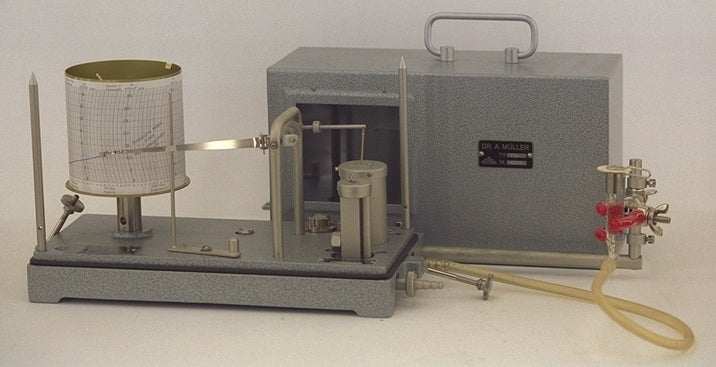Evaporation recorder
1 product
Showing 1 - 1 of 1 product
The Piche evaporation recorder is a recording Piche evaporometer. A 50 cm² filter paper disc serves as the evaporation body. A hose connection leads to a float vessel with a float, which is connected to a recording device for recording the evaporation height.
Water evaporates even at room temperature unless the air is saturated with water vapor, which would correspond to the dynamic equilibrium described above.
For example, the drying of laundry in the open air and the disappearance of puddles are based on the principle of water evaporation. The effect of evaporative cooling by water is the basis for the effect of thermoregulation through sweating, as the evaporative heat is removed from the skin, thereby cooling it.
In ecology, meteorology and climatology, a distinction is made between transpiration (sweating + leaf evaporation) and evaporation (evaporation of water on unvegetated / open land or water surfaces) as forms of evaporation, whereby both are also summarized under evapotranspiration.
The absorption of water into the Earth's atmosphere through evaporation takes place on the Earth's surface, for example, through water surfaces, soils, and plants. Evaporation depends primarily on the following factors:
• Air temperature
• Humidity
• Sunlight (season)
• Wind strength and, to a certain extent, wind direction
• Surface conditions (soil type, etc.) and vegetation
• Water content of the soil or amount of precipitation
Due to the diverse parameters on which evaporation depends, its determination is very difficult and time-consuming. Therefore, evaporation is usually not measured, but rather only approximated using mathematical models. The resulting evaporation per unit of time, or the evaporation rate, is referred to as the evaporation rate.
A distinction is made between potential evaporation, which represents the theoretically possible evaporation rate due to meteorological conditions, and actual evaporation, which takes into account the actual water content, for example, of the soil. Potential evaporation is always greater than or equal to actual evaporation. In dry conditions, especially in arid climates, the two values can differ significantly.

